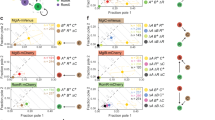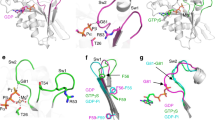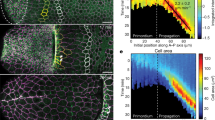Abstract
Dynamic control of cell polarity is of critical importance for many aspects of cellular development and motility. In Myxococcus xanthus, MglA, a G protein, and MglB, its cognate GTPase-activating protein, establish a polarity axis that defines the direction of movement of the cell and that can be rapidly inverted by the Frz chemosensory system. Although vital for collective cell behaviours, how Frz triggers this switch has remained unknown. Here, we use genetics, imaging and mathematical modelling to show that Frz controls polarity reversals via a gated relaxation oscillator. FrzX, which we identify as a target of the Frz kinase, provides the gating and thus acts as the trigger for reversals. Slow relocalization of the polarity protein RomR then creates a refractory period during which another switch cannot be triggered. A secondary Frz output, FrzZ, decreases this delay, allowing rapid reversals when required. Thus, this architecture results in a highly tuneable switch that allows a wide range of reversal frequencies.
This is a preview of subscription content, access via your institution
Access options
Access Nature and 54 other Nature Portfolio journals
Get Nature+, our best-value online-access subscription
$29.99 / 30 days
cancel any time
Subscribe to this journal
Receive 12 digital issues and online access to articles
$119.00 per year
only $9.92 per issue
Buy this article
- Purchase on Springer Link
- Instant access to full article PDF
Prices may be subject to local taxes which are calculated during checkout






Similar content being viewed by others
References
Guzzo, M. et al. Evolution and design governing signal precision and amplification in a bacterial chemosensory pathway. PLoS Genet. 11, e1005460 (2015).
Sliusarenko, O., Neu, J., Zusman, D. R. & Oster, G. Accordion waves in Myxococcus xanthus. Proc. Natl Acad. Sci. USA 103, 1534–1539 (2006).
Igoshin, O. A., Goldbeter, A., Kaiser, D. & Oster, G. A biochemical oscillator explains several aspects of Myxococcus xanthus behavior during development. Proc. Natl Acad. Sci. USA 101, 15760–15765 (2004).
Schumacher, D. & Søgaard-Andersen, L. Regulation of cell polarity in motility and cell division in Myxococcus xanthus. Annu. Rev. Microbiol. 71, 61–78 (2017).
Chang, Y.-W. et al. Architecture of the type IVa pilus machine. Science 351, aad2001 (2016).
Faure, L. M. et al. The mechanism of force transmission at bacterial focal adhesion complexes. Nature 539, 530–535 (2016).
Leonardy, S. et al. Regulation of dynamic polarity switching in bacteria by a Ras-like G-protein and its cognate GAP. EMBO J. 29, 2276–2289 (2010).
Mauriello, E. M. F. et al. Bacterial motility complexes require the actin‐like protein, MreB and the Ras homologue, MglA. EMBO J. 29, 315–326 (2010).
Treuner-Lange, A. et al. The small G-protein MglA connects to the MreB actin cytoskeleton at bacterial focal adhesions. J. Cell Biol. 210, 243–256 (2015).
Zhang, Y., Franco, M., Ducret, A. & Mignot, T. A bacterial Ras-like small GTP-binding protein and its cognate GAP establish a dynamic spatial polarity axis to control directed motility. PLoS Biol. 8, e1000430 (2010).
Miertzschke, M. et al. Structural analysis of the Ras-like G protein MglA and its cognate GAP MglB and implications for bacterial polarity. EMBO J. 30, 4185–4197 (2011).
Kaimer, C. & Zusman, D. R. Regulation of cell reversal frequency in Myxococcus xanthus requires the balanced activity of CheY-like domains in FrzE and FrzZ. Mol. Microbiol. 100, 379–395 (2016).
Inclán, Y. F., Vlamakis, H. C. & Zusman, D. R. FrzZ, a dual CheY-like response regulator, functions as an output for the Frz chemosensory pathway of Myxococcus xanthus. Mol. Microbiol. 65, 90–102 (2007).
Inclán, Y. F., Laurent, S. & Zusman, D. R. The receiver domain of FrzE, a CheA–CheY fusion protein, regulates the CheA histidine kinase activity and downstream signalling to the A- and S-motility systems of Myxococcus xanthus. Mol. Microbiol. 68, 1328–1339 (2008).
Kaimer, C. & Zusman, D. R. Phosphorylation-dependent localization of the response regulator FrzZ signals cell reversals in Myxococcus xanthus. Mol. Microbiol. 88, 740–753 (2013).
Leonardy, S., Freymark, G., Hebener, S., Ellehauge, E. & Søgaard-Andersen, L. Coupling of protein localization and cell movements by a dynamically localized response regulator in Myxococcus xanthus. EMBO J. 26, 4433–4444 (2007).
Keilberg, D., Wuichet, K., Drescher, F. & Søgaard-Andersen, L. A response regulator interfaces between the Frz chemosensory system and the MglA/MglB GTPase/GAP module to regulate polarity in Myxococcus xanthus. PLoS Genet. 8, e1002951 (2012).
Zhang, Y., Guzzo, M., Ducret, A., Li, Y.-Z. & Mignot, T. A dynamic response regulator protein modulates G-protein-dependent polarity in the bacterium Myxococcus xanthus. PLoS Genet. 8, e1002872 (2012).
Bowman, G. R. et al. Oligomerization and higher-order assembly contribute to sub-cellular localization of a bacterial scaffold. Mol. Microbiol. 90, 776–795 (2013).
Laloux, G. & Jacobs-Wagner, C. Spatiotemporal control of PopZ localization through cell cycle-coupled multimerization. J. Cell Biol. 201, 827–841 (2013).
Skerker, J. M., Prasol, M. S., Perchuk, B. S., Biondi, E. G. & Laub, M. T. Two-component signal transduction pathways regulating growth and cell cycle progression in a bacterium: a system-level analysis. PLoS Biol. 3, e334 (2005).
Thomas, S. A., Brewster, J. A. & Bourret, R. B. Two variable active site residues modulate response regulator phosphoryl group stability. Mol. Microbiol. 69, 453–465 (2008).
Smith, J. G. et al. A search for amino acid substitutions that universally activate response regulators. Mol. Microbiol. 51, 887–901 (2003).
Mauriello, E. M. F., Astling, D. P., Sliusarenko, O. & Zusman, D. R. Localization of a bacterial cytoplasmic receptor is dynamic and changes with cell–cell contacts. Proc. Natl Acad. Sci. USA 106, 4852–4857 (2009).
Igoshin, O. A., Mogilner, A., Welch, R. D., Kaiser, D. & Oster, G. Pattern formation and traveling waves in myxobacteria: theory and modeling. Proc. Natl Acad. Sci. USA 98, 14913–14918 (2001).
Igoshin, O. A., Welch, R., Kaiser, D. & Oster, G. Waves and aggregation patterns in myxobacteria. Proc. Natl Acad. Sci. USA 101, 4256–4261 (2004).
Zhang, H. et al. The mechanistic basis of Myxococcus xanthus rippling behavior and its physiological role during predation. PLoS Comput. Biol. 8, e1002715 (2012).
Bustamante, V. H., Martínez-Flores, I., Vlamakis, H. C. & Zusman, D. R. Analysis of the Frz signal transduction system of Myxococcus xanthus shows the importance of the conserved C-terminal region of the cytoplasmic chemoreceptor FrzCD in sensing signals. Mol. Microbiol. 53, 1501–1513 (2004).
Pogue, C. B., Zhou, T. & Nan, B. PlpA, a PilZ-like protein, regulates directed motility of the bacterium Myxococcus xanthus. Mol. Microbiol. 107, 214–228 (2018).
McLoon, A. L. et al. MglC, a paralog of Myxococcus xanthus GTPase-activating protein MglB, plays a divergent role in motility regulation. J. Bacteriol. 198, 510–520 (2015).
Jeong, J.-Y. et al. One-step sequence- and ligation-independent cloning as a rapid and versatile cloning method for functional genomics studies. Appl. Environ. Microbiol. 78, 5440–5443 (2012).
Morgenstein, R. M. et al. RodZ links MreB to cell wall synthesis to mediate MreB rotation and robust morphogenesis. Proc. Natl Acad. Sci. USA 112, 12510–12515 (2015).
Ducret, A., Quardokus, E. M. & Brun, Y. V. MicrobeJ, a tool for high throughput bacterial cell detection and quantitative analysis. Nat. Microbiol. 1, 16077 (2016).
Sprague, B. & McNally, J. FRAP analysis of binding: proper and fitting. Trends Cell Biol. 15, 84–91 (2005).
Acknowledgements
We thank L. Sogaard-Andersen and U. Gerland for discussions and V. Sourjik for comments on the manuscript. M.G. was the recipient of an ARC fellowship (DOC20140601482). E.M. is the recipient of an AMIDEX “Académie d’excellence” thesis fellowship (no. ANR-11-IDEX-0001-02). S.L. is funded by an ANR programme “BACTOCOMPASS”. T.M. is the recipient of an ERC starting grant “DOME 261105” and an ANR programme “BACTOCOMPASS”. R.V. was supported by the French Infrastructure for Integrated Structural Biology (FRISBI) ANR-10-INBS-05.
Author information
Authors and Affiliations
Contributions
M.G., S.M.M., E.M., S.L., M.H. and T.M. conceptualized the study. M.G., S.M.M., E.M., S.L., V.M., M.H. and T.M. conceptualized the methodology. M.G., S.M.M., E.M., S.L., L.M., G.B. and Y.Z. conducted the investigation. M.H. and T.M. wrote the original draft of the manuscript. M.G., S.M.M. and E.M. reviewed and edited the manuscript. M.G., S.M.M., E.M., S.L., L.E., M.H. and T.M. conducted the visualization experiments. M.H. and T.M. acquired funding. B.P.B., R.V., J.W.S. and M.V. provided resources. S.M.M. and M.H. conducted the mathematical analysis. M.H. and T.M. provided supervision.
Corresponding authors
Ethics declarations
Competing interests
The authors declare no competing interests.
Additional information
Publisher’s note: Springer Nature remains neutral with regard to jurisdictional claims in published maps and institutional affiliations.
Supplementary information
Supplementary Information
Supplementary Figures 1–6, Supplementary Tables 1–3, Supplementary Notes, Supplementary References.
Rights and permissions
About this article
Cite this article
Guzzo, M., Murray, S.M., Martineau, E. et al. A gated relaxation oscillator mediated by FrzX controls morphogenetic movements in Myxococcus xanthus. Nat Microbiol 3, 948–959 (2018). https://doi.org/10.1038/s41564-018-0203-x
Received:
Accepted:
Published:
Issue Date:
DOI: https://doi.org/10.1038/s41564-018-0203-x
This article is cited by
-
Molecular basis and design principles of switchable front-rear polarity and directional migration in Myxococcus xanthus
Nature Communications (2023)
-
Interplay of mesoscale physics and agent-like behaviors in the parallel evolution of aggregative multicellularity
EvoDevo (2020)
-
MglA functions as a three-state GTPase to control movement reversals of Myxococcus xanthus
Nature Communications (2019)
-
Spatial control of the GTPase MglA by localized RomR–RomX GEF and MglB GAP activities enables Myxococcus xanthus motility
Nature Microbiology (2019)
-
Evolutionary diversification of the RomR protein of the invasive deltaproteobacterium, Bdellovibrio bacteriovorus
Scientific Reports (2019)



